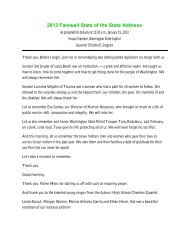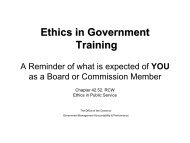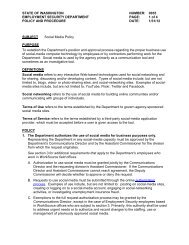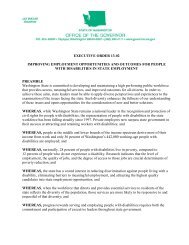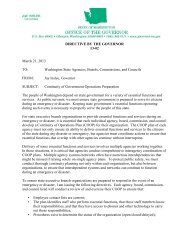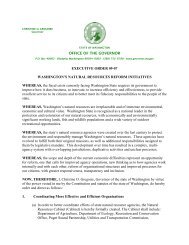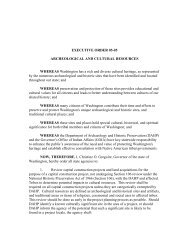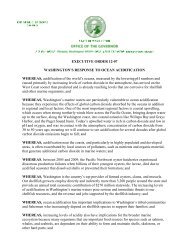Communicating Clearly with Charts and Graphs - Governor
Communicating Clearly with Charts and Graphs - Governor
Communicating Clearly with Charts and Graphs - Governor
You also want an ePaper? Increase the reach of your titles
YUMPU automatically turns print PDFs into web optimized ePapers that Google loves.
Part I. > B. <strong>Communicating</strong> <strong>with</strong> numbers<br />
Numbers tell certain types of stories<br />
• How many things are there?<br />
• How often do things happen?<br />
• What type or degree of change has happened?<br />
• Is change normal or unpredictable?<br />
• Is change likely to continue in the future (i.e. a trend)?<br />
When we use words to tell stories, we organize them in certain ways:<br />
• sentences<br />
• paragraphs<br />
In the same way, to get numbers to tell stories, we have to organize<br />
them in certain ways.<br />
• Tables are the first main tool for organizing numbers<br />
• In a table, we put numbers in rows <strong>and</strong> columns<br />
Every chart starts <strong>with</strong> a table of data, usually in a spreadsheet.<br />
Whether to put data in rows or columns is up to you:<br />
• Brian Willett likes dates in columns, going across the page<br />
• I like dates in rows, going down the page<br />
• We both produce similar graphs.<br />
Example of a data table<br />
Biennium Period Actual Target<br />
2003-05 Q1 59 58<br />
Q2 135 144<br />
Q3 174 210<br />
Q4 180 150<br />
Q5 117 58<br />
Q6 86 144<br />
Q7 188 210<br />
Q8 210 162<br />
2005-07 Q1 122 119<br />
Q2 79 108<br />
Q3 169 162<br />
Q4 157 151<br />
Q5 62 62<br />
Q6 105 121<br />
Q7 160<br />
Q8 197<br />
Source: Exercise 1 - DNR volume of timber sold<br />
<strong>Communicating</strong> <strong>with</strong> charts 4



